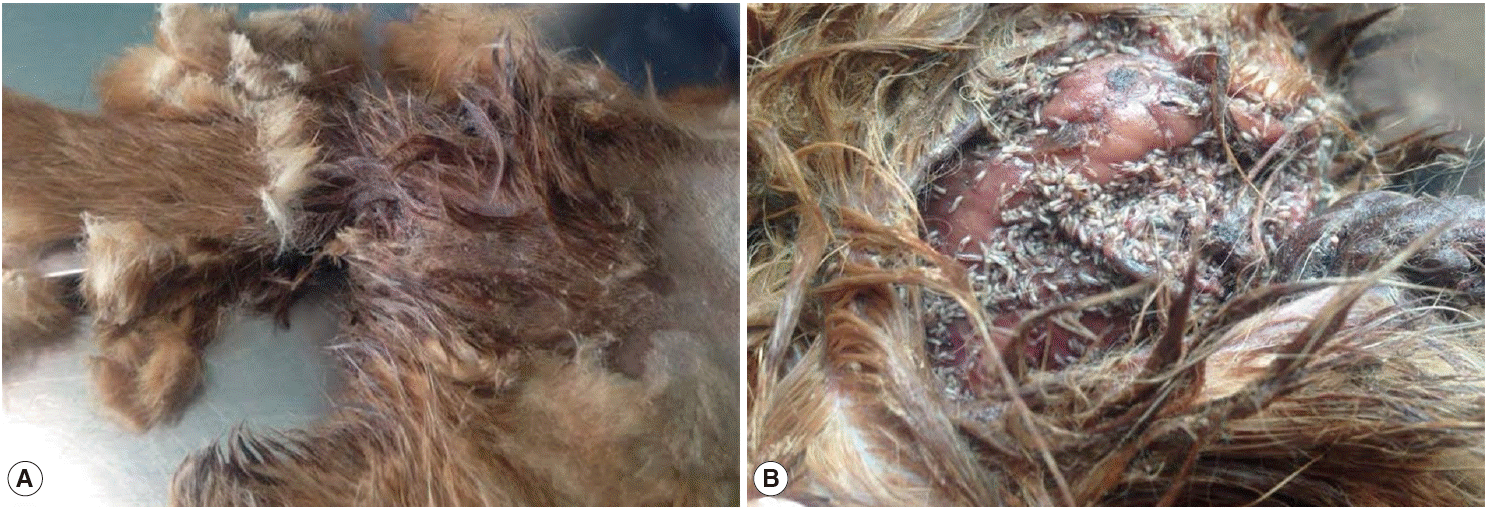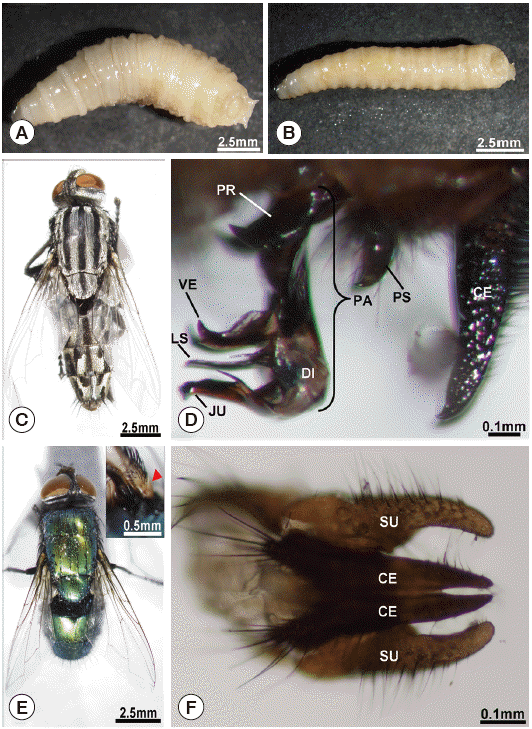INTRODUCTION
Myiasis is defined by Zumpt [1] as “the infestation of live human and vertebrate animals with dipterous larvae, which, at least for a certain period, feed on the host’s dead or living tissue, liquid body-substances, or ingested food”. Traumatic myiasis is caused by fly larvae infesting pre-existing traumatic lesions or actively gaining access to tissues [1]. Fly species that cause traumatic myiasis can be divided into obligate or facultative ones according to the nature of the host-parasite association. Obligate traumatic myiasis involves larvae that can only develop on living tissue, whereas in facultative myiasis the larvae can develop on both living and dead tissues [2]. Here, we describe a rare case of traumatic myiasis in a domestic cat (Felis catus L., Mammalia: Felidae) caused by an association of Sarcophaga tibialis Macquart (Diptera: Sarcophagidae) and Lucilia sericata (Meigen) (Diptera: Calliphoridae).
CASE DESCRIPTION
A 10-year old European shorthair cat, missing from home for about 3 days in August 2014, was found near its home in the village of San Martino (Ferrara province, Italy) with a large wound on the rump near the base of its tail, which was almost completely detached (Fig. 1A, B). The cat was brought to a veterinary clinic for treatment. The veterinaries assumed that the injury had been caused by a dog bite and found an extensive traumatic myiasis in the wound caused by a high number of Diptera larvae (Fig. 1B).
The veterinaries treating the cat collected 60 larvae (all first or second instar), which were placed in plastic test tubes and immediately brought to the Laboratory of Urban Ecology, Department of Life Sciences and Biotechnology, University of Ferrara, for identification. The wound was washed with an antiseptic (povidone-iodine), and ivermectin was administered subcutaneously. Afterwards, the cat’s tail was surgically amputated and during surgery the cat was drip-fed with physiological solution, a vitamin support, and a corticosteroid. After suturing the wound the cat was treated with broad-spectrum antibiotics (streptomycin and penicillin).
In the Laboratory of Urban Ecology the larvae were divided into 2 groups: 15 of them were immediately fixed in 4% formaldehyde and the other 45 were reared in a plastic box containing 90 g of cow liver, at 25˚C, 50% relative humidity and a 16/8 (L/D) photoperiod. Upon reaching the third instar, the larvae were again divided into 2 groups according to their length (respectively 14.8±0.7 mm and 11.6±1.0 mm) and aspect (Fig. 2A, B) and raised until the adult stage. Morphological investigations were performed with a Nikon SMZ 800 stereomicroscope (Nikon Instruments Europe, Amsterdam, The Netherlands) and a Nikon Eclipse 80i optical microscope (Nikon Instruments Europe), both connected to a Nikon Digital Sight Ds-Fil camera (Nikon Instruments Europe).
The identification of S. tibialis was carried out by examination of adult males (Fig. 2C) emerged from the first group of larvae, based mainly on aspects of the genitalia (Fig. 2D) and using the identification key of Richet et al. [3]. The identification of the second species as L. sericata was carried out using the identification key of Szpila [4] and was based on morphology of adult males (Fig. 2E) emerged from the second group of larvae, namely the bright yellow basicosta (Fig. 2E, inlay) and shape of the cerci and surstyli (Fig. 2F). All examined larvae and adults are deposited in the Laboratory of Urban Ecology, Department of Life Sciences and Biotechnology, University of Ferrara, Ferrara (Italy).
DISCUSSION
Reports of myiasis in cats are uncommon, probably because they usually groom themselves carefully [5]. In the present case, infestation by these 2 fly species was favoured by a deep and extensive wound that had weakened the cat, preventing it from properly grooming and cleaning its fur. Cases of myiasis in humans and animals caused by an association of more than one Diptera species have been reported in the literature. The species involved are Chrysomya rufifacies (Macquart) (Diptera: Calliphoridae) with Chrysomya megacephala (Fabricius) (Diptera: Calliphoridae) [6], Sarcophaga ruficornis (Fabricius) (Diptera: Sarcophagidae) with Musca domestica (Linnaeus) (Diptera: Muscidae), and C. megacephala [7] and Chrysomya bezziana Villeneuve (Diptera: Calliphoridae) with Lucilia sp. (Diptera: Calliphoridae) [8].
Myiasis caused by S. tibialis in association with another species had been reported only once, by Villeneuve [9] with Sarcophaga crassipalpis Macquart (Diptera: Sarcophagidae). L. sericata has been reported to cause myiasis in association with Chrysomya albiceps Wiedemann (Diptera: Calliphoridae) [5] and Wohlfahrtia magnifica (Schiner) (Diptera: Sarcophagidae) [10,11]. The case we report is the first of myiasis caused by an association of S. tibialis and L. sericata.
S. tibialis is a thermophilic, heliophilic, and generally synanthropic species [12], probably indigenous to the Afrotropical Region [13] and widespread in Africa (including the Canary Islands, Madagascar, and the Seychelles), central and southern Europe, Turkey, the Chagos Archipelago in the Oriental Region, and Oceania [14]. The species is widespread in Italy, including Sardinia and Sicily [15]. Like most Sarcophagidae, S. tibialis is larviparous [16], with eggs usually hatching inside the uterus. Eggs laid in groups or together with larvae have been reported not to hatch [17]. As in most flies, the rate of development is largely temperature-dependent [1]. Abasa [17] reported that at 20-22˚C the development from first larval stage to adult lasts about 20-27 days, whereas Aspoas [18] stated that at 25˚C development from first instar to adult lasts 20-22 days. Recently, Villet et al. [19] reported that the optimal temperature for development of this species (based on lowest larval mortality) is about 20˚C.
In our study, females of S. tibialis and L. sericata were attracted by the smell released by the wound and subsequently deposited larvae and eggs on it. Adults of S. tibialis are usually attracted by decaying matter such as carcasses and excrements [13,17,20], where larvae may or may not be laid. Larvae of this species have been reared in the laboratory on liver, fish carrion, fresh bird meat, dead snails, and chopped grasshoppers [3,17-19]. S. tibialis is also of potential forensic importance [12].
Only 2 well-documented cases of cutaneous human myiasis caused by S. tibialis were reported in the literature. Both occurred in Tripoli (Libya) in 1913, the first in May and the second in July. Both cases were connected to poor sanitation and the myiasis was localized to the scalp. The first case involved a bedridden boy affected by peritoneal tuberculosis and tinea capitis [16], the second occurred in a little girl affected by tinea capitis, pediculosis, and pyoderma [21]. According to these reports, the smell released by the infected scalp lesions attracted the adult flies. Onorato [16] hypothesized a possible connection between tinea capitis and cutanous myiasis by S. tibialis. Besides these 2 cases, there is a hint of another case of human traumatic myiasis in Algeria mentioned by Villeneuve [9], but without any further detail. Also, Patton and Evans [22] stated that S. tibialis is known to cause intestinal myiasis in Europe, but they did not report any data on the number of cases and localities of occurrence. Therefore, the present case is the first record of S. tibialis causing myiasis in Italy and is probably the first well-documented case of this kind in Europe.
On the other hand, L. sericata is a widely distributed agent of myiasis in temperate areas [2] and a probable cosmopolite [23]. In the United Kingdom, South Africa, and New Zealand, L. sericata is a relevant agent of myiasis in sheep [24]. It is widespread in the whole of Italy, including Sardinia and Sicily [15,25]. Adults are diurnal and commonly breed on carcasses, dirty or wet sheep fleece, garbage and manure; they are also attracted by open wounds and lesions where conditions are such that the larvae can complete their development, causing myiases such as fly strike in sheep. Females start to lay eggs 5-9 days after emerging from the puparium and within 3 weeks they lay 2,000-3,000 eggs in 9-10 batches [1]. The larval developmental rate is strongly temperature-dependent: between 22˚C and 29˚C, development from egg to adult occurs in 13-19 days [23].
In southern Europe, L. sericata is considered a synanthropic species associated to houses and rural areas undergoing urbanization [26,27]. Together with Calliphora vicina Robineau-Desvoidy (Diptera: Calliphoridae) and Lucilia illustris Meigen (Diptera: Calliphoridae), L. sericata is among the 3 species characterizing urban and suburban areas in Europe [28]. In our report the cat contracted myiasis in San Martino, a small country village about 4 km from the city of Ferrara (Ferrara province, Italy). Myiasis caused by L. sericata has been reported in domestic cats in America, Europe, and Asia and may be traumatic [5,29-33], gastrointestinal (anal and rectal) [5,34], urogenital (vaginal, penile and perineal) [30,35-37], or ocular [38]. Our report is the first case of traumatic myiasis by L. sericata in a domestic cat in Italy, albeit in association with S. tibialis. The only other case of myiasis by L. sericata in a domestic cat in Italy was a rectal one, although cutaneous myiases by this species have been reported in sheep and dogs [34], and humans [39,40].
The present results on the first case of myiasis caused by an association of S. tibialis and L. sericata and on the first case of myiasis by S. tibialis in Italy were obtained through a close cooperation between veterinaries and entomologists. Studies on the biology, distribution, and modes of infestation of Diptera causing myiasis could largely benefit from similar collaborations. Accurate and detailed information on the distribution of species of medical and veterinary interest is limited in Italy [41]. Thus, the compilation of an infestation map should be a priority objective for veterinary interventions and for ecological and biological studies.








